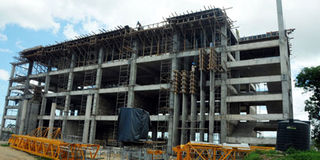How Lapsset area gained value

The ongoing construction of the Lamu Port South Sudan-Ethiopia Transport Corridor. There seems to be a consensus among policy makers, analysts and industrialists that there is a glaring industry skills gap in Kenya. PHOTO | FILE |
What you need to know:
- The turning point in Lamu’s fortunes came immediately the Narc Government came to power and showed a serious commitment to develop the port, even appointing a team to oversee its implementation.
- The Lamu Port-Southern Sudan-Ethiopia Transport (Lapsset) Corridor Development Authority was formed, setting in motion a flurry activities that also escalated land grabbing in the area.
Just 15 years ago, the Lamu land that is now the subject of intense debate was an idle, forested area that nobody was keen to buy.
The huge tracts were only important to the hunter-gatherer Boni community and timber merchants who used to make money out of logging.
A senior provincial administrator who worked in Lamu in the late 1990s and early 2000s said there was nothing particularly significant about the land which had in earlier years been used as a hiding place for shifta bandits.
“Little did we know that the same idle land would today turn out to be prime land that people are scrambling for because of the multibillion-shilling port project,” said Laikipia County Commissioner Wilson Wanyanga, a former Lamu DC.
The turning point in Lamu’s fortunes came immediately the Narc Government came to power and showed a serious commitment to develop the port, even appointing a team to oversee its implementation.
The Lamu Port-Southern Sudan-Ethiopia Transport (Lapsset) Corridor Development Authority was formed, setting in motion a flurry activities that also escalated land grabbing in the area.
A local resident, Mr Mohamed Ali Baddi, said talk of developing a port in Lamu started way back in the 1970s when a former area MP, Mr Omar Mzamil broached the issue in Parliament.
“A feasibility study was done by a Swiss Company after that but the government went mum about the proposal,” said Mr Baddi, now the coordinator of Lamu Environmental Preservation and Conservation (LEPAC), an NGO.
Mr Baddi is also a shareholder of Amu Ranch which is set on 65,000 acres. The ranch was one of those whose title deeds were ordered revoked last week.
“We got our letter of allotment in 1974 and got the title in 2009 but because most of the members who come from diverse backgrounds little has been done on the property,” he said.
According to Ali Shebwana, a conservationist and TNA politician, the scramble for Lamu land started about ten years ago when some villagers living near the proposed port land were asked to start looking for land elsewhere and plans for compensating them started.
To date, he said, 146 families of those families are yet to receive compensation for their land. A consultant hired by the government to carry out the valuation recommended that they be paid Sh1.5 million per acre. Mr Kassim Shahare is one of the people affected by the project and is still awaiting for his compensation.
“We have lived in this area for over 30 years but now my 4.5 acres of land have been taken by the project. Some people who were not residents of this area started coming when they heard that we would be compensated and complicated the matter,” he said. “But the original list that was drawn by the consultant hired by the government is still intact and we expect to be paid.” Those eyeing the land in Lamu came up with proposals to start mega projects within the area and got clearance from the Lamu County Council and the District Development Committee to justify the allocation of thousands of acres of land.




